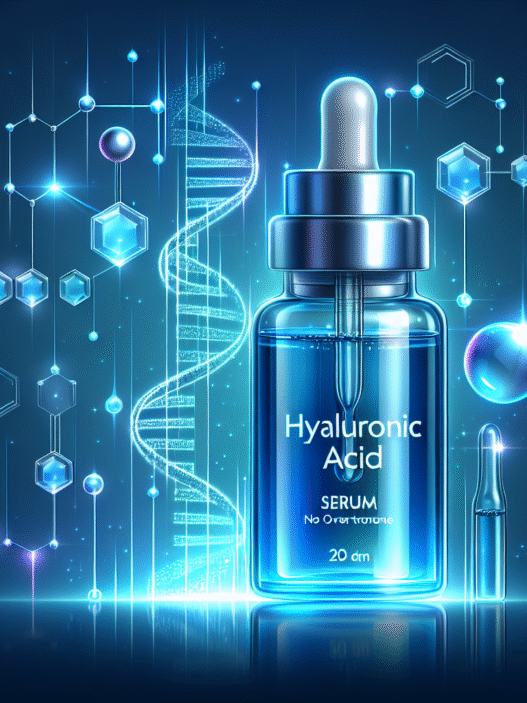Hyaluronic Acid & Skincare Ingredients
Understanding the interaction between hyaluronic acid and other skincare ingredients is vital for achieving healthy and youthful skin. Hyaluronic acid is known for its hydrating properties, which can complement various active ingredients. However, some combinations may require caution.
Retinol & Hyaluronic Acid
Retinol, including synthetic forms such as Tretinoin, is popular for its ability to stimulate collagen production, enhance skin cell turnover, and smooth wrinkles. However, it can cause dry skin, irritation, redness, and increased sensitivity to sunlight (USA Today). Incorporating hyaluronic acid can help soothe the irritation caused by retinol, making it a beneficial pairing.
| Ingredient | Benefits | Cautions |
|---|---|---|
| Retinol | Stimulates collagen, smooths wrinkles | Can cause dryness and irritation |
| Hyaluronic Acid | Provides hydration, calms irritation | None specifically as it hydrates |
Vitamin C & Hyaluronic Acid
Vitamin C serves as a potent antioxidant, mitigating free radical damage and supporting a bright complexion. Paired with hyaluronic acid, this combination effectively moisturizes and enhances anti-aging benefits. For optimal results, it is often recommended to combine Vitamin C with Vitamin E and Ferulic Acid. Together, these ingredients promote smoother, more even-toned skin.
| Ingredient | Benefits | Cautions |
|---|---|---|
| Vitamin C | Brightens skin, fights oxidative stress | Can be unstable without proper formulation |
| Hyaluronic Acid | Hydrates and protects | None specifically as it hydrates |
Salicylic Acid & Hyaluronic Acid
Salicylic acid is well-known for treating breakouts by exfoliating and clearing clogged pores. This can sometimes lead to skin irritation. By combining salicylic acid with hyaluronic acid, individuals can counteract dryness and soothe irritation, while restoring moisture.
| Ingredient | Benefits | Cautions |
|---|---|---|
| Salicylic Acid | Treats acne, exfoliates | Can irritate skin |
| Hyaluronic Acid | Restores moisture, soothes irritation | None specifically as it hydrates |
Incorporating hyaluronic acid into a skincare routine can offers numerous benefits, particularly when combined thoughtfully with other active ingredients. Keep in mind the interactions and effects to optimize skincare results and achieve healthy skin. For further reading on what hyaluronic acid does to your skin, visit our article on what does hyaluronic acid do to your skin?.
Interactions to Avoid
When formulating a skincare routine, it’s important to know what not to mix with hyaluronic acid?. Certain combinations can lead to adverse effects or diminish the effectiveness of the products. Below are key interactions to avoid, particularly involving retinol, a popular anti-aging ingredient.
Retinol and Benzoyl Peroxide
Combining retinol with benzoyl peroxide can render the retinol ineffective. This mixture can lead to excessive dryness, flaking, or skin irritation. Since both ingredients are powerful, using them together can overwhelm the skin and cause adverse reactions.
| Ingredient Combination | Possible Effects |
|---|---|
| Retinol + Benzoyl Peroxide | Ineffectiveness, dryness, flaking, irritation |
Retinol and Vitamin C
Another combination to avoid is retinol and vitamin C. Using these two powerful ingredients together may cause irritation and redness, especially for individuals with sensitive skin. A better approach is to use them on alternate days or in a daytime and nighttime skincare routine, allowing each product to effectively work without overwhelming the skin (Skin Software Journal).
| Ingredient Combination | Possible Effects |
|---|---|
| Retinol + Vitamin C | Irritation, redness, sensitivity |
Retinol and Salicylic Acid
Mixing retinol with salicylic acid can also lead to heightened skin sensitivity, redness, or irritation. While both ingredients have benefits, including helping with dark spots and acne, they should be introduced slowly and cautiously into the skincare routine. Users may benefit from seeking guidance on how to effectively integrate both without adverse reactions.
| Ingredient Combination | Possible Effects |
|---|---|
| Retinol + Salicylic Acid | Redness, irritation, heightened sensitivity |
By being aware of these interactions, individuals can optimize their skincare routine while minimizing potential adverse effects. It’s important to determine the best approach when combining powerful ingredients to promote skin health effectively. For more information on how hyaluronic acid affects the skin, refer to our article on what does hyaluronic acid do to your skin?.
Best Practices for Skincare Combos
In understanding effective skincare combinations, it is important to consider which ingredients work harmoniously together. This section outlines some best practices for combining certain skincare ingredients, particularly in relation to hyaluronic acid.
Vitamin C with AHAs/BHAs
While Vitamin C is well-regarded for its antioxidant properties, it is not advisable to mix it with Alpha Hydroxy Acids (AHAs) or Beta Hydroxy Acids (BHAs). The interaction can increase the potency of Vitamin C, potentially leading to severe skin irritation (Skin Software Journal). Layering these products may also disrupt the skin’s pH balance, rendering them ineffective (True Botanicals).
To illustrate the pH levels and their implications, consider the following table:
| Ingredient | Ideal pH Level | Interaction Effects |
|---|---|---|
| Vitamin C | 2.0 – 3.5 | Highly effective, but irritating with AHAs/BHAs |
| AHAs/BHAs | 3.0 – 4.0 | Can disrupt Vitamin C effectiveness |
Niacinamide with AHAs/BHAs
Niacinamide has been shown to work well with a variety of skincare ingredients, including AHAs and BHAs. While some combinations can lead to irritation, when used in moderation, niacinamide can provide hydration and barrier support. This combination can help balance the potential drying effects of AHAs/BHAs.
For those with sensitive skin, it is wise to introduce niacinamide slowly and monitor the skin’s response. Here’s a table of suggested combinations:
| Ingredient | Compatible with | Notes |
|---|---|---|
| Niacinamide | AHAs/BHAs | Provides hydration without significant irritation |
| Niacinamide | Hyaluronic Acid | Enhances moisture retention in skin |
Hyaluronic Acid & Vitamin C Pairing
The combination of hyaluronic acid and Vitamin C can be highly beneficial for the skin. While Vitamin C protects against free radicals, hyaluronic acid provides deep hydration. They can be used together, but it is crucial to layer them correctly: apply hyaluronic acid first, followed by Vitamin C. This layering allows for optimal absorption, enhancing both products’ effectiveness.
| Ingredient Combination | Benefits |
|---|---|
| Hyaluronic Acid + Vitamin C | Deep hydration and antioxidant protection |
| Application Order | Hyaluronic Acid first, then Vitamin C |
Using these best practices when combining hyaluronic acid with other skincare ingredients can optimize results while minimizing irritation. For further insights on hyaluronic acid’s effects on skin, read more on what does hyaluronic acid do to your skin? and the benefits of staying within optimal ingredient pairings.





















